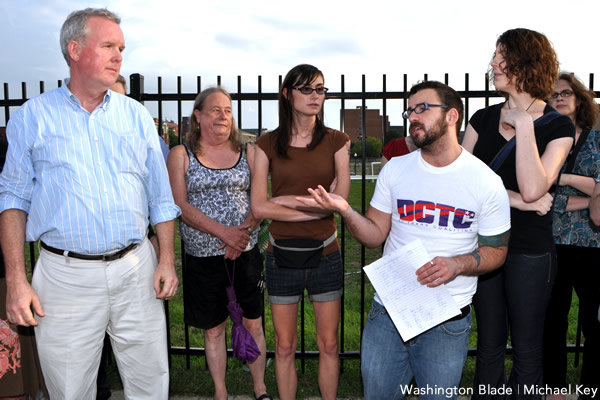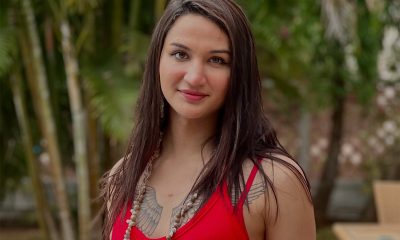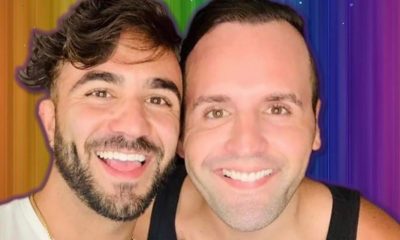Local
Off-duty D.C. cop arrested for shooting trans women
Activists, Mayor Gray express shock, outrage
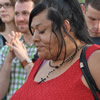
D.C. Mayor Vincent Gray joined LGBT activists on Friday in expressing shock and outrage over news that an off-duty District police officer allegedly fired a pistol at three transgender women and two male friends while the group was sitting in a car on a city street.
Police issued a statement Friday saying three of the people in the car “sustained non-life threatening injuries” in the incident. The statement said the officer involved in the incident was charged with assault with a dangerous weapon and driving while intoxicated.
Deputy Police Chief Diane Groomes told the Blade that the officer, identified by police sources as Kenneth Furr, was stripped of his police duties pending the outcome of an investigation by the department’s Internal Affairs Division and Force Investigation Team.
MORE IN THE BLADE: TRANS ACTIVISTS HOLD PROTEST OUTSIDE POLICE, US ATTORNEY OFFICES
In a separate statement released earlier in the day, Mayor Gray expressed “shock and outrage” over the incident.
“I am deeply troubled by the apparent circumstances surrounding this incident and await the results of a full MPD investigation,” Gray said. “These are serious charges, and they are particularly disturbing to have been brought against one who is sworn to protect and serve.”
Gray praised members of the LGBT community, including officials with the local group Transgender Health Empowerment, for providing immediate assistance to the victims and help in the police investigation.
Employees with Transgender Health Empowerment and members of the D.C. Trans Coalition said they spoke on Friday with two of the transgender women involved in the incident. According to the employees and the DCTC members, the two women said the incident started when Officer Furr, appearing drunk, approached one of the two women on the street near First and Pierce Streets, N.W. about 5:25 a.m.
They said the two victims informed them that Furr became angry when he solicited one of the women for sex and she turned him down. What unfolded next remains unclear, with police officials saying they wanted to wait until Furr appeared in court on Saturday or Monday before providing full details as they known them.
“Preliminary investigation reveals a confrontation occurred involving an off-duty officer and five other individuals, some of which are members of the transgender community,” police said in a statement released Friday morning. “The officer discharged a handgun and one person was shot and sustained non-life threatening injuries,” the statement says.
“Two other individuals involved in the incident sustained injuries which are also non-life threatening,” according to the statement. “The nature of those injuries is under investigation to determine their cause.”
T.H.E. employee and transgender activist Jeri Hughes said two of the trans women involved in the incident told her organization that one of them was struck by a bullet in the hand and the other was grazed by a bullet. Hughes said one of the men in the car with the three trans women, who was identified as the brother of one of the women, sustained a “very serious” gunshot wound and was in critical condition at George Washington University Hospital.
Police would neither confirm nor deny that report as of late Friday, saying they were still investigating the details of the incident.
About 70 people turned out for a 6:30 p.m. rally at the site of the shooting, which was organized by T.H.E. and DCTC. Among those who spoke at the rally were D.C. Council member Tommy Wells (D-Ward 6) and Groomes, who said she was appearing on behalf of Police Chief Cathy Lanier.
DCTC member Elijah Edelman told the gathering that Friday’s shooting of at least two transgender women by an off-duty police officer was one of many attacks and assaults against trans women that have occurred in the past few months in D.C.
“So I think it’s fair to say a lot of us are really pissed off,” he said. “It’s very, very frustrating. We had conversations with Chief Lanier over the past several weeks, over the past several years, and nothing changes – nothing changes,” Edelman said. “So this is a moment in which we can finally say enough – we’re not going to keep doing this.”
Other activists speaking at the rally, including D.C. Trans Coalition member Ruby Corado, praised the police handling of the latest incident. They said they were hopeful that police were finally carrying out a department policy for transgender related matters that was excellent “on paper” but had not been followed very often by rank and file officers.
In the latest case, the department’s Gay and Lesbian Liaison Unit was called immediately to provide help, Groomes told the rally. She said the GLLU, in turn, immediately alerted LGBT activists on its e-mail list about the incident and what the unit was doing to respond.
Two Latino transgender women who spoke at the rally gave personal accounts of attacks against them in the city. Both women spoke in Spanish, with Corado translating their remarks in English. One told of how she was beaten and raped two weeks ago by an ex-boyfriend. The other women told of how she was attacked inside Dupont Circle by a male assailant who she is certain targeted her because of her status as a transgender woman.
“We wanted them to come here so we can put a human face on the statistics of so many of these cases that continue to happen,” Corado said.
Others speaking at the rally included A.J. Singletary of Gays and Lesbians Opposing Violence (GLOV), Cyndee Clay of Helping Individual Prostitutes Survive (HIPS), and Sadie Vashti of D.C. Trans Coalition.

Maryland
Silver Spring holds annual Pride In The Plaza
‘Today means inclusion. It means to build resilience’
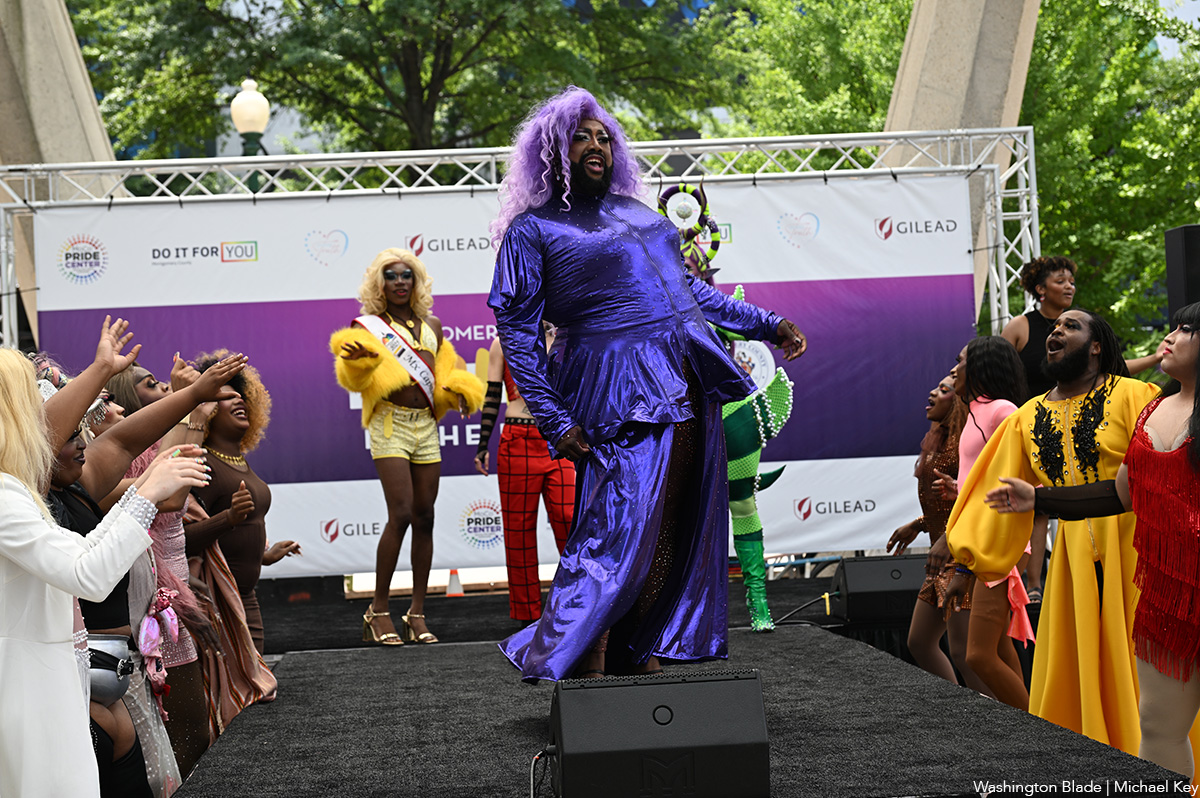
Silver Spring’s annual Pride in the Plaza event took place on Sunday to celebrate the LGBTQ community and emphasize inclusion and resilience.
“Today means inclusion. It means to build resilience, love,” Robyn Woods, program and outreach director for Live In Your Truth, which organized the event, said. “I mean, just being surrounded by the community and so many great entrepreneurs, business owners, and just being a part of this whole rainbow coalition that we call the LGBTQIA to be about.”
With the event being her first time organizing for Live In Your Truth, Woods said she felt emotional to see the support and love at the event.
“Some people (are) bringing out their children, their babies, their grandparents,” Woods said. “It’s a lot more allies here than anything else. That type of support to me means so much more than just support from my community; just outside support, inside support, so much support around it, so much love. Everyone’s smiling outside, helping each other.”
Attendees of the event were able to head over to the Family Fun Zone, an air-conditioned Pride Cool Down Lounge, or watch live drag performances in the main stage area.
Along with entertainment and a shaved-ice stand, rows of information tables stood along the plaza, including FreeState Justice, the Washington Spirit, Trans Maryland, Moco Pride Center, and the Heartwood Program, an organization that offers support, therapy, education, and resources to the LGBTQ community.
“I want people to know about our services, and I love what we have to offer,” Jessica Simon, psychotherapist for Heartwood Program’s Gender Wellness Clinic, said. “I (also) want to be part of a celebration with the community, and so it feels good to be here with other people who have something they want to give to the community.”
She added that within today’s political climate, to which she called an “antidote to shame,” it’s important to be celebrating Pride.
“There’s a lot of demonization of LGBTQI people,” Siena Iacuvazzi, facilitator for Maryland Trans Unity, said. “(Pride) is part of the healing process.”
Iacuvazzi said she was taught to be ashamed of who she was growing up, but being a part of a community helped her flourish in the future.
“I was taught how to hate myself. I was taught that I was an abomination to God,” she said. “But being a community is like understanding that there are people who have experienced the same thing, and they’re flourishing. They’re flourishing because they’re willing to stand up for themselves as human beings and discover themselves and understand what’s true for themselves.”
She added that Pride allows for a mutual understanding to take place.
“It’s more of a sense of belonging … and just taking that home and understanding you’re not alone,” Iacuvazzi said. “We’re each taking our own journey — we’re not putting that on each other. It’s just walking away with a sense of belonging and humanity.”
Similar to Iacuvazzi, Woods said she hopes attendees’ biggest takeaways would be family, fun, resilience, and pride.
“Being proud of yourself, being happy for who you are, and representation and how much it matters,” she continued. “And I think all these young people that are walking around here get to see versions of themselves, but older. They get to see so many different lesbian, gay, bisexual, pansexual people that are successful, that are showing love, that care, and it’s not how we’re portrayed in the media. It’s lovely to see it out here. (It’s) like we’re one big old, happy family.”
Virginia
Spanberger touts equality, reproductive rights in Arlington
Democratic Va. gubernatorial nominee made campaign stop at Freddie’s Beach Bar
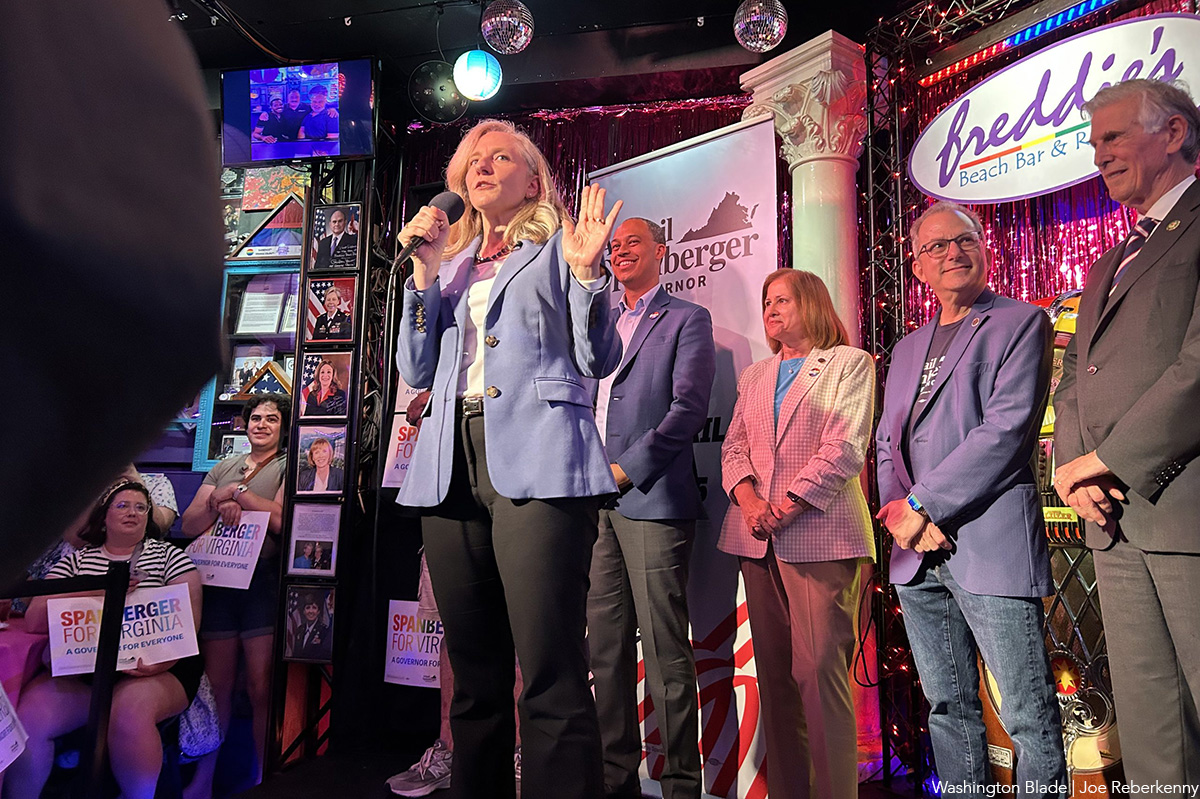
With the general election heating up and LGBTQ rights under increasing threat nationwide, Virginia gubernatorial candidate Abigail Spanberger brought her “Span Virginia Bus Tour” to Arlington’s Freddie’s Beach Bar for a campaign stop filled with cheers, policy pledges, and community spirit.
Spanberger, who served three terms in the U.S. House of Representatives from 2019 through early 2025 for Virginia’s 7th Congressional District, also served as a federal law enforcement officer specializing in narcotics and money laundering cases, and as a CIA case officer working on counterterrorism and nuclear counterproliferation.
Spanberger is running against Republican nominee Winsome Earle-Sears, the current lieutenant governor of Virginia, who said she was “morally opposed” to a bill protecting marriage equality in the commonwealth.
She was joined by other Democratic candidates and supporters: lieutenant gubernatorial candidate Ghazala Hashmi, attorney general candidate Jay Jones, Virginia state Sen. Adam Ebbin (D-Alexandria), and Congressman Don Beyer.
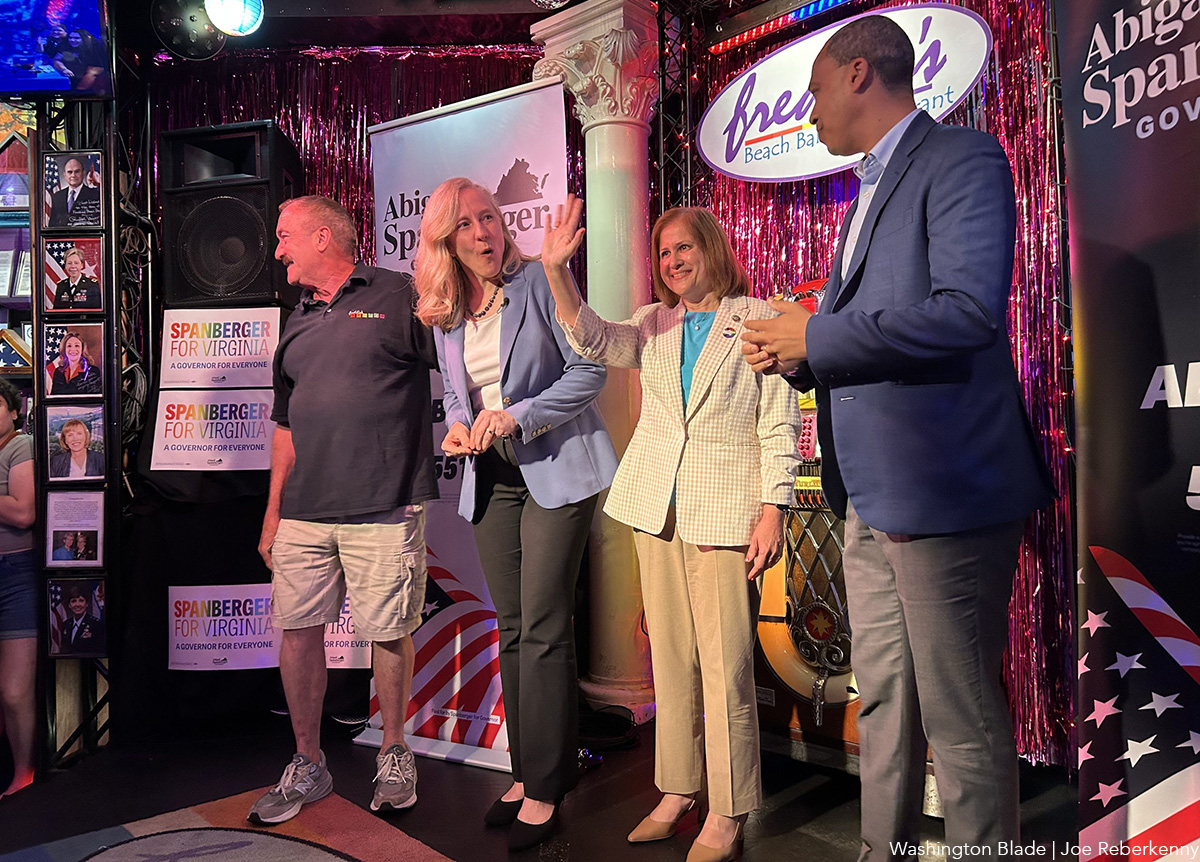
Freddie’s was packed wall-to-wall with supporters, many of whom wore “Spanberger for Virginia” shirts in the progressive Pride flag colors. In her speech, she made it clear that LGBTQ Virginians’ rights are on the ballot this year.
“I’m so excited to be here, and I am so grateful to the entire staff of Freddy’s for letting us overtake this incredible venue that is not just an awesome place to come together in community, but is a symbol to so many people of joy, of happiness, of community and of celebrating our friends and our neighbors,” Spanberger told the packed restaurant. “It is exciting to be here, and particularly during this Pride month, and particularly as we reflect on the 10-year anniversary of Obergefell and the reality that we still have so much work to do.”
“The reality is there are so many people who still would be inclined to take us backwards,” she said. “In this moment when we see attacks on people’s rights, on people’s humanity, on Virginia, on our economy, on research, on public education, on food security, on health care, on Virginians, on their jobs, on public service and on people — it can get heavy.”
“What it does for me is it makes me want to double down, because once upon a time, when I was talking to my mother about some horror show or sequence of activities coming out of a particular administration, she did not really have the patience to listen to me and said ‘Abigail, let your rage fuel you’ — and the conversation was over. And so I reflect on that, because, in fact, every day there is so much fuel to be had in this world and in this moment.”
One of the points Spanberger continued to emphasize was the importance of steadfast state government officials following the election of President Donald Trump, which has led to rollbacks of LGBTQ and bodily autonomy rights as a result of the conservative-majority U.S. Supreme Court.
“What the past few years have shown us is that a Supreme Court decision, no matter how many years we have celebrated its existence, does not protect us in the long term. And so as governor, I will work to make sure that every protection we can put in place for the dignity, the value, and the equal rights of all Virginians is a priority.”
During her speech, Spanberger highlighted several of the key values driving her campaign — protecting reproductive freedom and human rights, lowering healthcare costs, safeguarding Virginia’s environment, and ensuring that public education is affordable, accessible, and rooted in truth, not politics.
Spanberger went as far as to say that she wants to amend the state’s constitution to remove Section 15-A. “The reality is that in Virginia, we still have a ban in our state constitution on marriage equality. It is of the utmost urgency that we move forward with our constitutional amendment.”
“We will work to ensure that that terrible constitutional amendment, that was put in years ago, is taken out and updated and ensuring that Virginia is reflective in our most essential documents of who we are as a commonwealth, which is an accepting place that celebrates the vibrancy of every single person and recognizes that all Virginians have a place, both in that constitution and in law,” she added.
Following the event, two supporters spoke to the Washington Blade about why they had come out to support Spanberger.
“I came out because I needed to show support for this ticket, because it has been a particularly rough week, but a long few years for our rights in this country, in this state, with this governor, and it’s — we need to flip it around, because queer people need protection,” said Samantha Perez, who lives in Ballston. “Trans people need protection. Trans kids need protection. And it’s not gonna happen with who’s in Richmond right now, and we just need to get it turned around.”
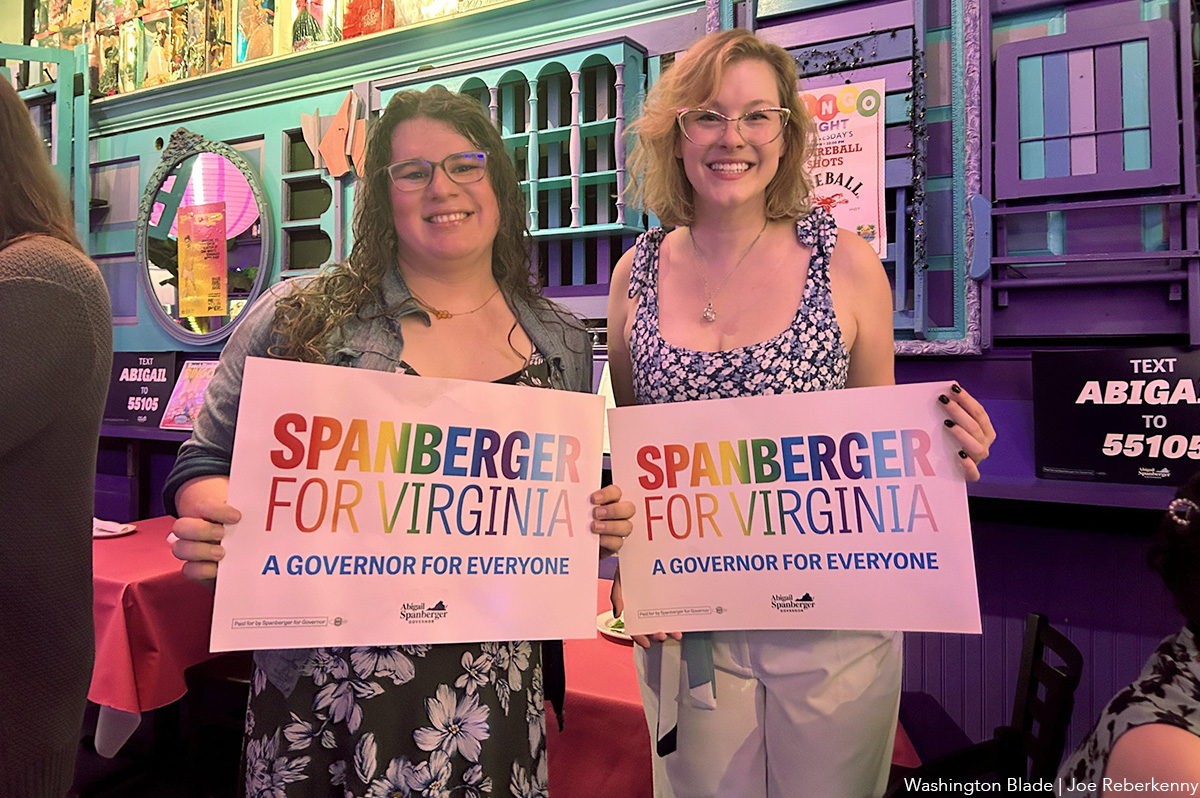
“The whole neighborhood’s here. All our friends are here,” said Annie Styles of Pentagon City. “It means the world to me to take care of each other. That’s what a good community does. That’s not what we’ve had with the Republicans here or across the nation for a really long time. It’s time to show that care. It’s time to make sure that good people are in a position to do good things.”
District of Columbia
Activists protest outside Hungarian Embassy in DC
Budapest Pride scheduled to take place Saturday, despite ban
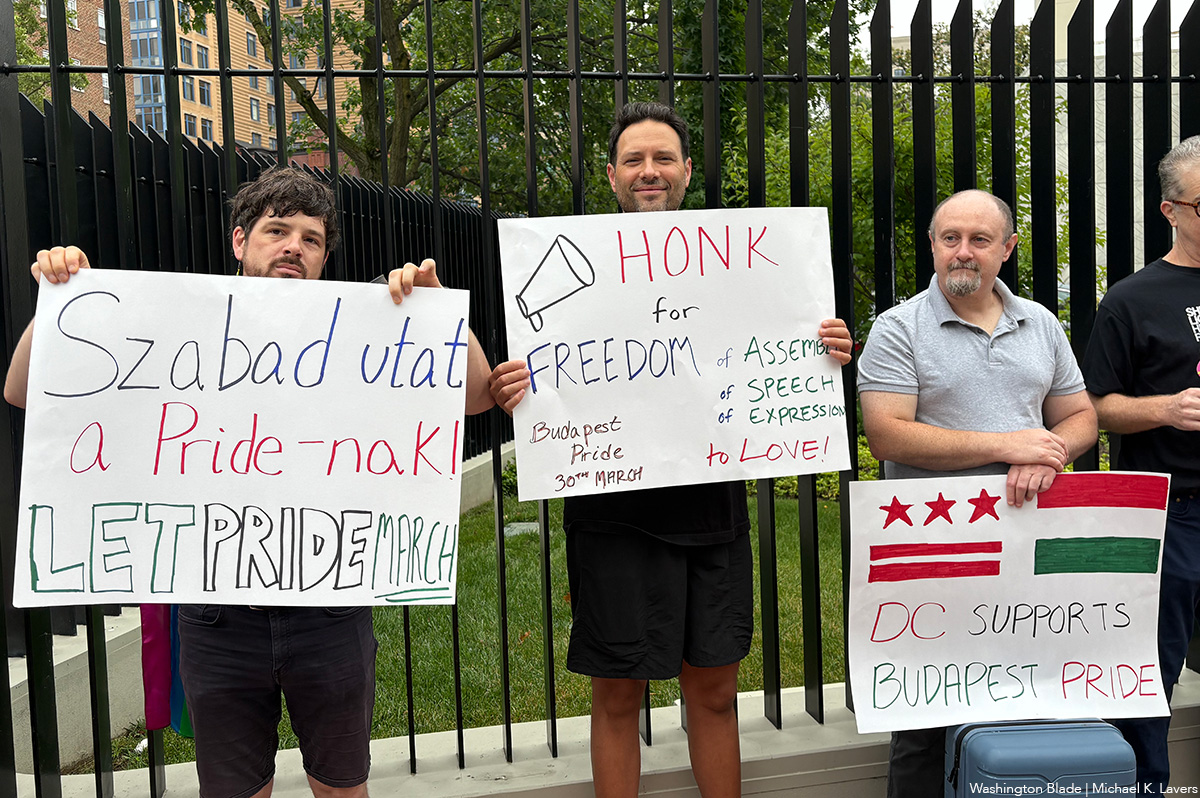
More than two dozen activists gathered in front of the Hungarian Embassy in D.C. on Friday to protest the country’s ban on Budapest Pride and other LGBTQ-specific events.
Amnesty International USA Executive Director Paul O’Brien read a letter that Dávid Vig, executive director of Amnesty International Hungary, wrote.
“For 30 years Budapest Pride has been a celebration of hope, courage, and love,” said Vig in the letter that O’Brien read. “Each march through the streets of Budapest has been a powerful testament to the resilience of those who dare to demand equality, but a new law threatens to erase Pride and silence everyone who demands equal rights for LGBTI people.”
“The Hungarian government’s relentless campaign against LGBTI rights represents a worrying trend that can spread normalizing division and hatred,” added Vig. “Thank you for standing with us when we refuse to be intimidated.”
Council for Global Equality Chair Mark Bromley and two of his colleagues — Stephen Leonelli and Keifer Buckingham — also spoke. Health GAP Executive Director Asia Russell and Chloe Schwenke, a political appointee in the Obama-Biden administration who worked for the U.S. Agency for International Development, and Planned Parenthood staffers are among those who attended the protest.
(Washington Blade video by Michael K. Lavers)
Hungarian lawmakers in March passed a bill that bans Pride events and allow authorities to use facial recognition technology to identify those who participate in them. MPs in April amended the Hungarian constitution to ban public LGBTQ events.
Budapest Pride is scheduled to take place on Saturday, despite the ban. Hundreds of European lawmakers are expected to participate.
“Sending strength to the patriotic Hungarians marching tomorrow to advance human dignity and fundamental rights in a country they love,” said David Pressman, the gay former U.S. Ambassador to Hungary, on Friday on social media.
Sending strength to the patriotic Hungarians marching tomorrow to advance human dignity and fundamental rights in a country they love. Szabadság és szerelem. My past remarks on Budapest Pride: https://t.co/y1QhA9QouA
— David Pressman (@AmbPressman) June 27, 2025
-

 U.S. Supreme Court4 days ago
U.S. Supreme Court4 days agoSupreme Court upholds ACA rule that makes PrEP, other preventative care free
-

 U.S. Supreme Court4 days ago
U.S. Supreme Court4 days agoSupreme Court rules parents must have option to opt children out of LGBTQ-specific lessons
-

 National5 days ago
National5 days agoEvan Wolfson on the 10-year legacy of marriage equality
-
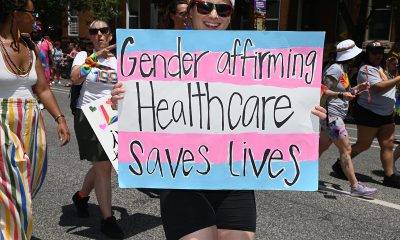
 Congress5 days ago
Congress5 days agoSenate parliamentarian orders removal of gender-affirming care ban from GOP reconciliation bill

